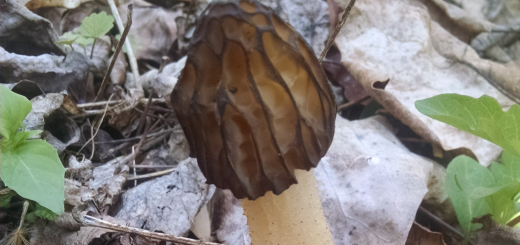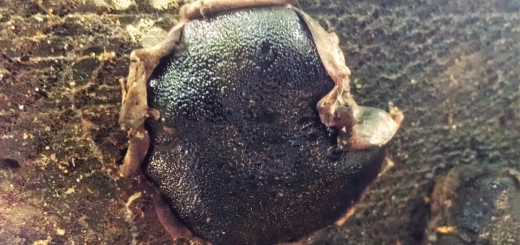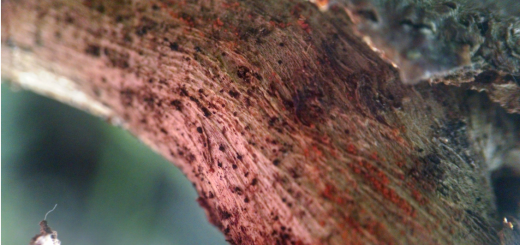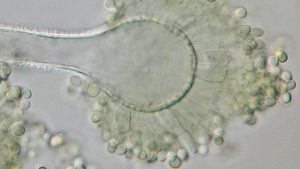#139: Disciotis venosa, the Bleach Cup
This medium-sized to large cup fungus is distinguished by the prominent vein-like wrinkles on its upper surface. Although it resembles any number of other brown cup fungi, it belongs to the family Morchellaceae and is actually a close relative of true morels! This similarity is borne out through microscopic examination, which may be required for accurate identification. Disciotis venosa is commonly known as the “Bleach Cup,” since it gives off a bleach-like odor when broken, and as the “Veined Cup Fungus,” thanks to its veined upper surface.
Like most other large cup fungi, D. venosa is shaped like an irregular cup (frequently with a rolled-up margin) when young and flattens out to become more saucer-shaped as it ages. Even though the Bleach Cup can grow to sizes of 3-21cm (1-8in) in diameter, its light brown color makes it difficult to spot on the forest floor. The upper surface can be reddish-brown to brown to yellowish-brown, making it roughly colored like a leafy forest floor. Although the Bleach cap is known for its veined upper surface, younger specimens may be mostly smooth. Large, mature specimens display the most intricate wrinkles, especially near the center of the cup. The lower surface is much paler in color, usually whitish to very light brown, and features a scattering of tiny, brown scales. D. venosa mushrooms are attached to the ground by a short, thick stipe that is usually buried in the soil. When broken, the Bleach Cup’s flesh is pale brown in color and has a bleach-like odor. The mushroom does share some macroscopic characteristics with morels, most notably its odor before being broken and its rubbery/brittle texture.
D. venosa is a saprobic species, but – given its close relation to the morels – it seems likely that it can form mycorrhizae under certain conditions. The Bleach Cup can be found during morel season (early to mid-spring) on the ground under hardwoods, where it grows alone or in large, spread-out groups. In Eastern North America, it prefers beeches, maples, oaks, and hickories. West of the Rocky Mountains, it prefers to fruit near rivers and streams under a variety of hardwoods. D. venosa can also be found in Europe.
There are a number of other brown-colored cup fungi present in North American forests, so you may need a microscope to definitively identify your cup fungus. In the case of D. venosa, the important part of the mushroom is the upper surface. This surface houses the spore-bearing asci. In the Bleach Cup, each ascus contains eight spores and does not turn blue when Melzer’s reagent (an iodine solution) is applied. The spores are elliptical (22-25 micrometers by 12-15 micrometers), smooth, and do not contain large oil droplets. These features are typical of the Morchellaceae and should help to separate D. venosa from other large cup fungi in the Pezizales (including species of Peziza, Helvella, and Gyromitra).
Most people do not bother trying to eat D. venosa, which means there is no consensus on whether or not it is edible. RogersMushrooms considers it poisonous while Wikipedia (supported by a Pacific Northwest field guide) considers it a choice edible. Mycologist Tom Volk reports that those who have eaten it liken the Bleach Cup’s flavor to that of morels. Since it is related to morels, D. venosa likely contains toxins similar to those found in morels. Morels must always be cooked before being eaten to remove these toxins. If you are going to try eating the Bleach Cup, then I recommend that you make sure it is well cooked beforehand. However, a safer course of action would be to redouble your morel hunting efforts when you come across this mushroom!
See Further:
http://botit.botany.wisc.edu/toms_fungi/may2008.html
http://www.mushroomexpert.com/disciotis_venosa.html
http://www.rogersmushrooms.com/gallery/DisplayBlock~bid~5693.asp









![#011: Characteristics of Kingdom Fungi [Archived]](https://www.fungusfactfriday.com/wp-content/themes/hueman/assets/front/img/thumb-small-empty.png)


1 Response
[…] which also includes the morels (Morchella spp.) and the cup fungus genus Disciotis (see FFF#139, Disciotis venosa).1,4 Given how closely verpas are related to morels, it is perhaps no […]